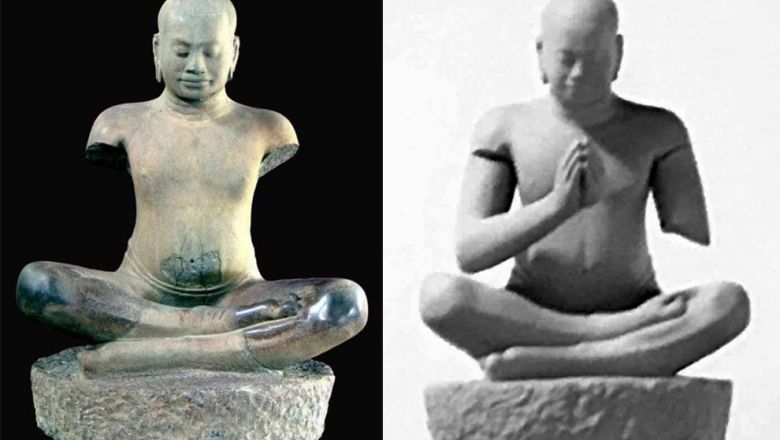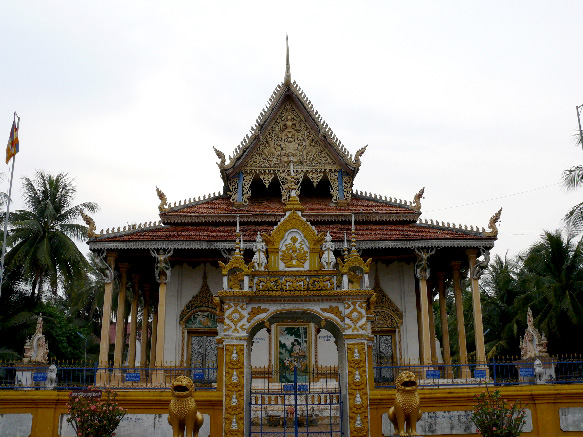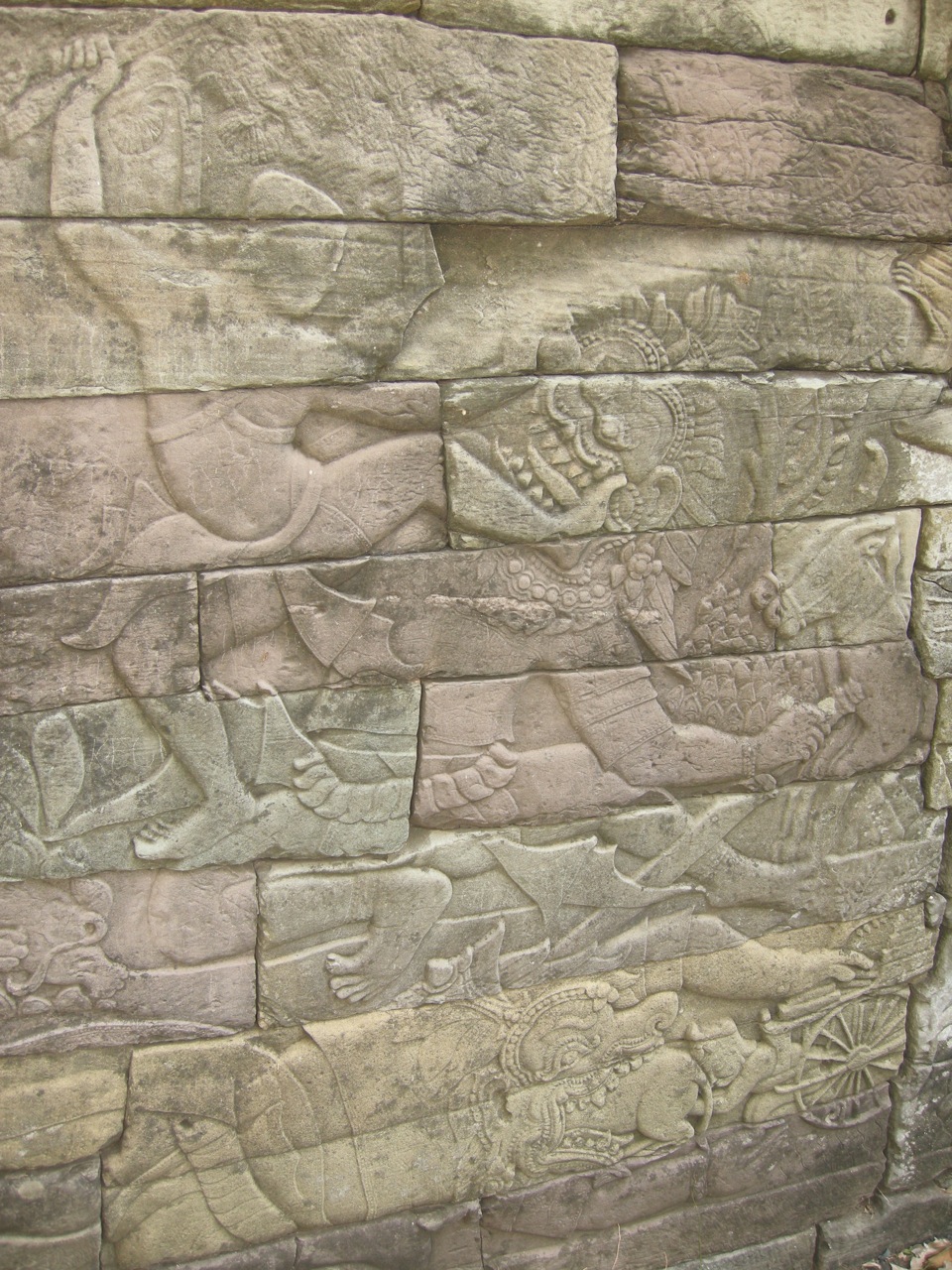|
Jayavarman VII
Jayavarman VII, posthumous name of Mahaparamasaugata ( km, ជ័យវរ្ម័នទី៧, c. 1122–1218), was king of the Khmer Empire. He was the son of King Dharanindravarman II (r. 1150–1160) and Queen Sri Jayarajacudamani. He was the first king devoted to Buddhism, as only one prior Khmer king was a Buddhist. He then built the Bayon as a monument to Buddhism. Jayavarman VII is generally considered the most powerful of the Khmer monarchs by historians. His government built many projects including hospitals, highways, rest houses and temples. With Buddhism as his motivation, King Jayavarman VII is credited with introducing a welfare state that served the physical and spiritual needs of the Khmer people. Defeat of the Cham and coronation In 1177 and again in 1178, the Cham invaded the Khmer Empire. In 1177, Champa King Jaya Indravarman IV launched a surprise attack on the Khmer capital by sailing a fleet up the Mekong River, across Lake Tonlé Sap, and then up ... [...More Info...] [...Related Items...] OR: [Wikipedia] [Google] [Baidu] |
Bust Of Jayavarman VII
The portrait of Jayavarman VII is a stone bust carved in Angkor during the late 12th or early 13th century representing Jayavarman VII and currently conserved at the Guimet Museum in Paris. It is one of the landmarks of the aesthetics of the Bayon style. Description The bust of Jayavarman VII is a grey-green sandstone head, with downcast eyes and a faint smile. The hairstyle, with the hair pulled into a small round bun at the top of the skull, makes it possible to identify the subject as being a man; the four squatting men sculpted on the pediment of the temple of Banteay Srei, kept at the Guimet museum, have practically the same hairstyle. The square face with full cheeks suggests that the character of Angkor is middle-aged. He wears no adornment and displays a meditative expression. The upper lip, a little longer than the lower lip, seems to protrude slightly; this would make one think that he had his teeth slightly forward, unless this effect is due to the flat mustache whi ... [...More Info...] [...Related Items...] OR: [Wikipedia] [Google] [Baidu] |
Buddhism
Buddhism ( , ), also known as Buddha Dharma and Dharmavinaya (), is an Indian religion or philosophical tradition based on teachings attributed to the Buddha. It originated in northern India as a -movement in the 5th century BCE, and gradually spread throughout much of Asia via the Silk Road. It is the world's fourth-largest religion, with over 520 million followers (Buddhists) who comprise seven percent of the global population. The Buddha taught the Middle Way, a path of spiritual development that avoids both extreme asceticism and hedonism. It aims at liberation from clinging and craving to things which are impermanent (), incapable of satisfying ('), and without a lasting essence (), ending the cycle of death and rebirth (). A summary of this path is expressed in the Noble Eightfold Path, a training of the mind with observance of Buddhist ethics and meditation. Other widely observed practices include: monasticism; " taking refuge" in the Buddha, the , and the ; ... [...More Info...] [...Related Items...] OR: [Wikipedia] [Google] [Baidu] |
Vientiane
Vientiane ( , ; lo, ວຽງຈັນ, ''Viangchan'', ) is the capital and largest city of Laos. Vientiane is divided administratively into 9 cities with a total area of only approx. 3,920 square kilometres and is located on the banks of the Mekong, close to the Thai border. Vientiane was the administrative capital during French rule and, due to economic growth in recent times, is now the economic center of Laos. The city had a population of 948,477 as of the 2020 Census. Vientiane is noted as the home of the most significant national monuments in Laos – That Luang – which is a known symbol of Laos and an icon of Buddhism in Laos. Other significant Buddhist temples in Laos can be found there as well, such as Haw Phra Kaew, which formerly housed the Emerald Buddha. The city hosted the 25th Southeast Asian Games in December 2009, celebrating 50 years of the Southeast Asian Games. Etymology 'Vientiane' is the French name derived from the Lao ''Viangchan'' . The name wa ... [...More Info...] [...Related Items...] OR: [Wikipedia] [Google] [Baidu] |
Vidyanandana
Vidyanandana, Shri Suryavarmadeva, or Suryavarman, was a Cham prince in Cambodia, who in 1182 put down a revolt that broke out at Malyang against Jayavarman VII. He arrived in Jayavarman VII's court in 1182 from Tumpraukvijaya, and was educated as a prince "in all branches of knowledge and all weapons". In 1190 he took part in the war against Champa and seized the capital Vijaya, capturing King Jaya Indravarman IV. Adopting the title of Shri Suryavarmadeva, he made himself king of Panduranga. He made Prince In, a brother-in-law of Jayavarman VII, "King Suryajayavarmadeva in the Nagara of Vijaya" (or Suryajayavarman).Maspero, G., 2002, The Champa Kingdom, Bangkok: White Lotus Co., Ltd., In 1191, Jaya Indravarman oṅ Vatuv summoned troops from Amaravati, Ulik, Vvyar, Jriy and Traik, deciding to revolt against Khmer rule. Indravarman oṅ Vatuv and his rebels drove Suryajayavarmadeva back to Cambodia, enthroning himself as Jaya Indravarman V. Vidyanandana/Suryavarman also then r ... [...More Info...] [...Related Items...] OR: [Wikipedia] [Google] [Baidu] |
Battambang
Battambang ( km, បាត់ដំបង, UNGEGN: ) is the capital of Battambang Province and the third largest city in Cambodia. Founded in the 11th century by the Khmer Empire, Battambang is the leading rice-producing province of the country. For nearly 100 years it was a major commercial hub and provincial capital of Siamese province of Inner Cambodia (1795-1907), though it was always populated by Khmer, with some ethnic Vietnamese, Lao, Thai and Chinese. Battambang remains the hub of Cambodia's northwest, connecting the region with Phnom Penh and Thailand. The city is situated on the Sangkae River, a tranquil, small body of water that winds its way picturesquely through Battambang Province. As with much of Cambodia, French Colonial architecture is a notable aspect of the city, with some of the best-preserved examples in the country. Now the government and Ministry of Culture and Fine Art are preparing documents to nominate The Old Town of Battambang in the list of UNESC ... [...More Info...] [...Related Items...] OR: [Wikipedia] [Google] [Baidu] |
Banteay Chmar
Banteay Chhmar ( km, បន្ទាយឆ្មារ ) is a commune (khum) in Thma Puok District in Banteay Meanchey province in northwest Cambodia. It is located 63 km north of Sisophon and about 20 km east of the Thai border. The commune of Banteay Chhmar contains 14 villages. The massive temple of Banteay Chhmar, along with its satellite shrines and reservoir (''baray''), comprises one of the most important and least understood archaeological complexes from Cambodia's Angkor period. History Like Angkor Thom, the temple of Banteay Chhmar was constructed during the reign of Jayavarman VII in the late 12th or early 13th century. One of the temple's shrines once held an image of Srindrakumararajaputra (the crown prince), a son of Jayavarman VII who died before him.Higham, C., 2001, The Civilization of Angkor, London: Weidenfeld & Nicolson, The temple doors record Yasovarman I's failed invasion of Champa.Maspero, G., 2002, The Champa Kingdom, Bangkok: White Lotus ... [...More Info...] [...Related Items...] OR: [Wikipedia] [Google] [Baidu] |
Siem Reap River
The Siem Reap River (Steung Siem Reap; km, ស្ទឹងសៀមរាប) is a river flowing through Siem Reap Province, in north-west Cambodia. The Siem Reap River was originally an offtake channel constructed during the Angkor period, used to divert water from the Puok River southward, probably to the East Baray. Because of the straight nature of a channel, the water flowed much faster than in a natural river. This caused the bed of the channel to erode as much as 10 meters in some areas, and probably caused problems with diverting the water to the East Baray. Over the past thousand years, the channel has gained small meander A meander is one of a series of regular sinuous curves in the channel of a river or other watercourse. It is produced as a watercourse erodes the sediments of an outer, concave bank ( cut bank) and deposits sediments on an inner, convex ba ...s and a unique ecosystem, and thus it is more accurate to call it a river. References Rivers o ... [...More Info...] [...Related Items...] OR: [Wikipedia] [Google] [Baidu] |
Tonlé Sap
Tonlé Sap (; km, ទន្លេសាប, ; or commonly translated as 'Great Lake'; vi, Biển Hồ, Chữ Hán: 湖海/壺海) is a lake in the northwest of Cambodia. It belongs to the Mekong, Mekong River system. It is the largest freshwater lake in Southeast Asia and one of the most diverse and productive ecosystems in the world, designated as a Biosphere Reserve by UNESCO in 1997 due to its high biodiversity. Entering the 21st century, the lake and its surrounding ecosystems are under increasing pressure from Deforestation in Cambodia, deforestation, infrastructure development and Climate change in Cambodia, climate change. Geography Tonlé Sap Lake is located in the northwest of the lower Mekong plain, formed by the collision and collapse of the Indian Plate and the Eurasian Plate. The lower Mekong plain used to be a bay, and the sea level rose rapidly at the end of the last glacial period. About high, cores from this period found near Angkor contain tidal deposits ... [...More Info...] [...Related Items...] OR: [Wikipedia] [Google] [Baidu] |
Mekong
The Mekong or Mekong River is a trans-boundary river in East Asia and Southeast Asia. It is the world's List of rivers by length, twelfth longest river and List of longest rivers of Asia, the third longest in Asia. Its estimated length is , and it drains an area of , discharging of water annually. From the Tibetan Plateau the river runs through China, Myanmar, Laos, Thailand, Cambodia, and Vietnam. The extreme seasonal variations in flow and the presence of rapids and waterfalls in the Mekong make navigation difficult. Even so, the river is a major trade route between western China and Southeast Asia. Names The Mekong was originally called ''Mae Nam Khong'' from a contracted form of Tai language, Tai shortened to ''Mae Khong''. In Thai and Lao, ''Mae Nam'' ("Mother of Water[s]") is used for large rivers and ''Khong'' is the proper name referred to as "River Khong". However, ''Khong'' is an archaic word meaning "river", loaned from Austroasiatic languages, such as Vietnamese ... [...More Info...] [...Related Items...] OR: [Wikipedia] [Google] [Baidu] |
Jaya Indravarman IV
Jaya Indravarman IV was the king of Champa, a former region located within modern-day Vietnam, from 1167–1192. He probably was the same person as Panduranga ruler, Po Klong Garai. A usurper, "he called himself Jaya Indravarman on Vatu and said he came from the 'famous place known by the name Gramapuravijaya." He was "full of energy, courage and pride...well versed in all the shastra." He sent tribute to the Court of China and the Dai Viet. Unsuccessful in purchasing horses from China for an overland invasion, he prepared a squadron of water vessels.Maspero, G., 2002, The Champa Kingdom, Bangkok: White Lotus Co., Ltd., He is noted for leading the Champa invasion of the Khmer Empire in 1177. His naval forces traveled up the Mekong and Tonle Sap rivers to Tonle Sap and sacked Angkor, killing Tribhuvanadityavarman.Higham, C., 2001, The Civilization of Angkor, London: Weidenfeld & Nicolson, In 1190, the Khmer king Jayavarman VII, the son and successor of Dharanindravarman II ... [...More Info...] [...Related Items...] OR: [Wikipedia] [Google] [Baidu] |
David P
David (; , "beloved one") (traditional spelling), , ''Dāwūd''; grc-koi, Δαυΐδ, Dauíd; la, Davidus, David; gez , ዳዊት, ''Dawit''; xcl, Դաւիթ, ''Dawitʿ''; cu, Давíдъ, ''Davidŭ''; possibly meaning "beloved one". was, according to the Hebrew Bible, the third king of the United Kingdom of Israel. In the Books of Samuel, he is described as a young shepherd and harpist who gains fame by slaying Goliath, a champion of the Philistines, in southern Canaan. David becomes a favourite of Saul, the first king of Israel; he also forges a notably close friendship with Jonathan, a son of Saul. However, under the paranoia that David is seeking to usurp the throne, Saul attempts to kill David, forcing the latter to go into hiding and effectively operate as a fugitive for several years. After Saul and Jonathan are both killed in battle against the Philistines, a 30-year-old David is anointed king over all of Israel and Judah. Following his rise to power, David ... [...More Info...] [...Related Items...] OR: [Wikipedia] [Google] [Baidu] |





